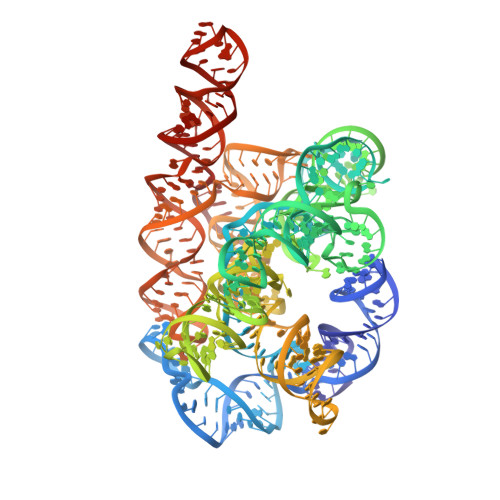Topological crossing in the misfolded Tetrahymena ribozyme resolved by cryo-EM.
Li, S., Palo, M.Z., Pintilie, G., Zhang, X., Su, Z., Kappel, K., Chiu, W., Zhang, K., Das, R.(2022) Proc Natl Acad Sci U S A 119: e2209146119-e2209146119
- PubMed: 36067294
- DOI: https://doi.org/10.1073/pnas.2209146119
- Primary Citation of Related Structures:
7XSK, 7XSL, 7XSM, 7XSN - PubMed Abstract:
The Tetrahymena group I intron has been a key system in the understanding of RNA folding and misfolding. The molecule folds into a long-lived misfolded intermediate (M) in vitro , which has been known to form extensive native-like secondary and tertiary structures but is separated by an unknown kinetic barrier from the native state (N). Here, we used cryogenic electron microscopy (cryo-EM) to resolve misfolded structures of the Tetrahymena L-21 ScaI ribozyme. Maps of three M substates (M1, M2, M3) and one N state were achieved from a single specimen with overall resolutions of 3.5 Å, 3.8 Å, 4.0 Å, and 3.0 Å, respectively. Comparisons of the structures reveal that all the M substates are highly similar to N, except for rotation of a core helix P7 that harbors the ribozyme's guanosine binding site and the crossing of the strands J7/3 and J8/7 that connect P7 to the other elements in the ribozyme core. This topological difference between the M substates and N state explains the failure of 5'-splice site substrate docking in M, supports a topological isomer model for the slow refolding of M to N due to a trapped strand crossing, and suggests pathways for M-to-N refolding.
Organizational Affiliation:
MOE Key Laboratory for Cellular Dynamics and Division of Life Sciences and Medicine, University of Science and Technology of China, Hefei, Anhui 230027, China.














